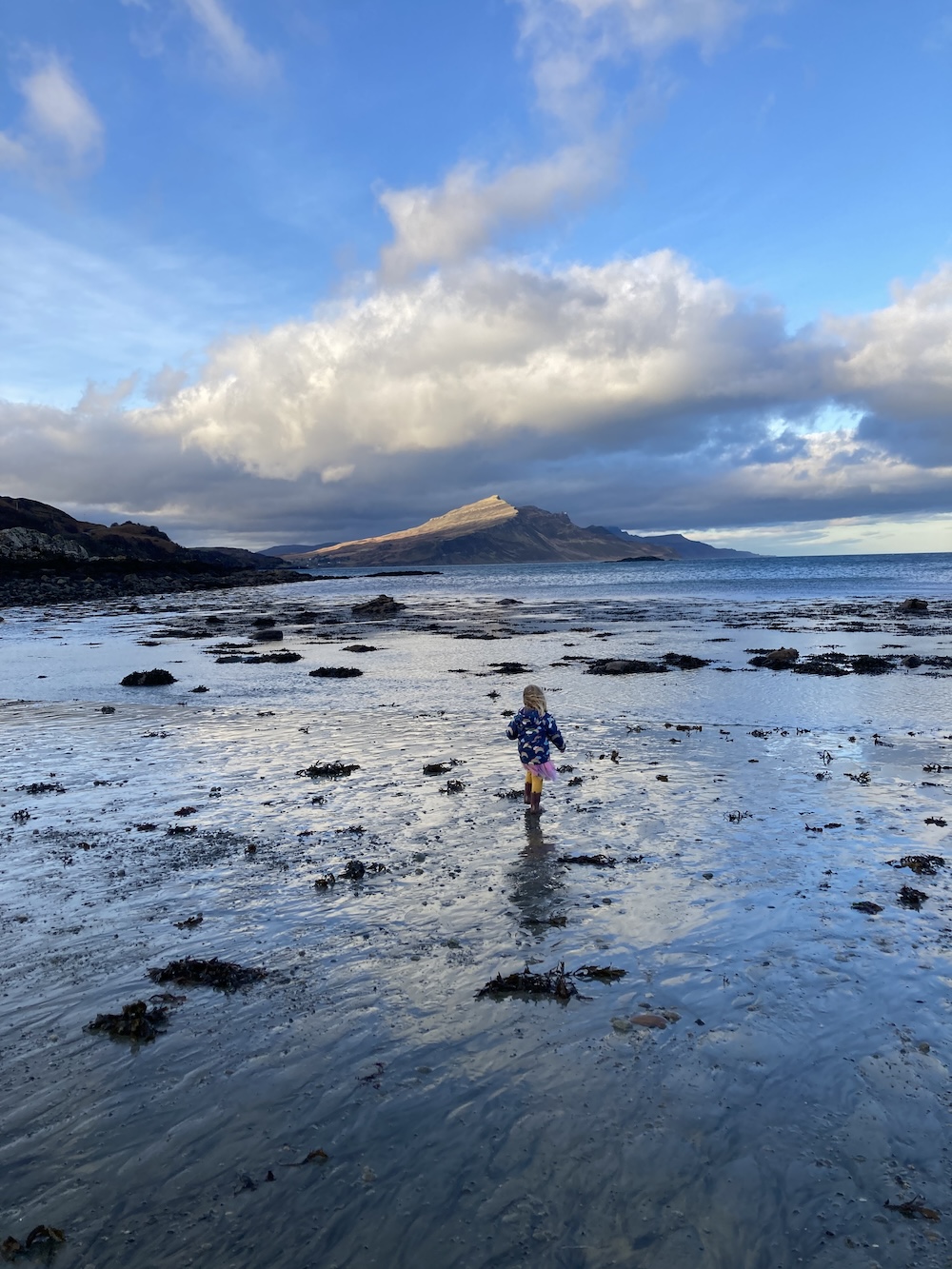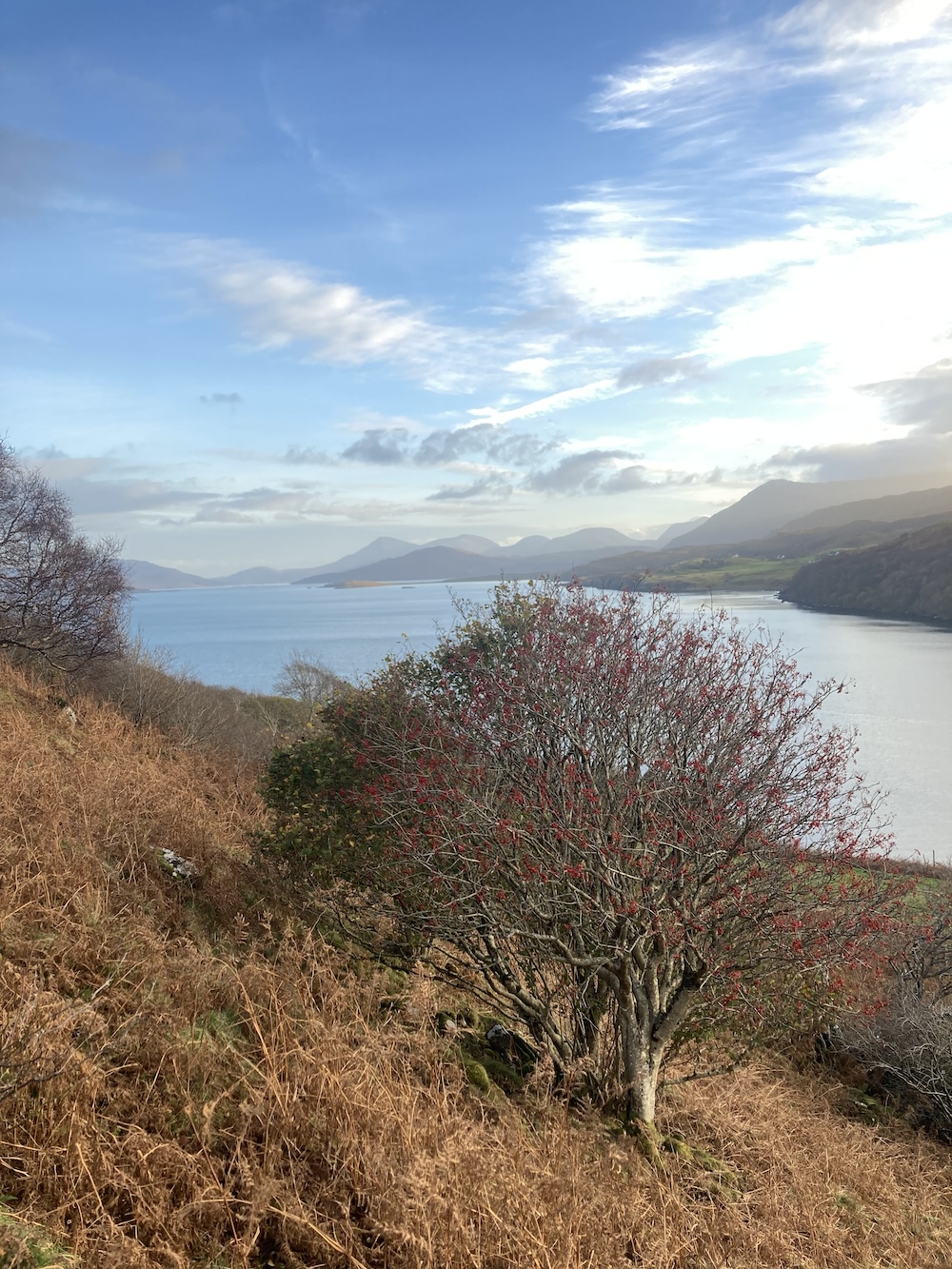Bethan Roberts celebrates her fourth winter on the Isle of Skye.

They say that you have to survive three winters on Skye to know that you can stick living here. I’m heading into my fourth, and I am as ambivalent as ever, as changeable as the weather. At times over the past year I’ve felt a deeper sense of rootedness and belonging, perhaps; at others a newly terrifying sense of unmoored-ness, no longer sure of where, or what, is ‘home’.
There has been a falling into the rhythm of the seasons, a deeper familiarity with the cycle of the year. The cuckoo eight days earlier than last year, the redwings a few days later than last (I’m sloppy with my record keeping). The unfurling of the bracken from tightly curled fronds to six-foot-high tick forests, decaying back down to the ground from which those tender green curls will emerge again. The inexorable green fuse.
And with this has come the desire, the ability to write about this place. So what I can say is that that takes three years. It seems to make sense that my daughter will locate her first memories from around this time, my emerging words somehow mapped onto the memories she lays down. And she too has found her words this year, her vocabulary exploding: foxglove, robin, fresh.
A friend swims every day of the year, she says it’s her way of finding a place in the landscape, her way of being on Skye. I realise that writing is my way. A working out of my sense of Skye and my relationship with it. And you do have to find a way to be here, and to be here all year round, working both with and against the motions of the tourist season; as an incomer too, ever a tourist yourself to the culture and history of the Gàidhealtachd. In turn, place itself, the Gàidhealtachd, Skye, seeking its own way to be, skewed and cracking under the pressures of tourism and second homes.
The cottage looks out to the southeast over the sound of Raasay and I can find the view, the everchanging interplay of weather and light and sea and sky – never the same from one day to the next, one minute to the next – exhausting. Beautiful, of course, stunning, exhilarating, yes, but sometimes I long for steadiness. Each morning I open the curtains, unsure what to expect. There is another saying here, about the weather – ‘four seasons in a day’. I enjoy, then, the slow unfurling of the seasons themselves, the gradual onset of autumn, the imperceptible shifts in colour until everything is on a spectrum of browns and greys, oranges and reds, a richness in decay. Not just the trees, but sweeping the ground too across bracken and heather. Autumn colour suits the island, which seems to sit most in itself with its hues of mist, smoke, peat, rock. Fire and whisky. Bracken and heather drained to rust. Flashes of red, gold, silver.
The tourists have gone and there’s the sense of the island rewilding itself. Eagles and dolphins no longer performing for visitors on boat trips. Is it me or are the birds getting closer? There’s a heron in the road as I drive out of the village, the sea eagles are lower than ever over the hill and bay. Kestrel and sparrowhawk, disagreement over whether there is a peregrine. Our patch one of raptors. Diurnal, the dive to kill, pale undersides catching the light, exposed in the bare branches of trees, a certain barrenness, bone. A buzzard has taken up residence right down in the low scrubby trees of the village, starting from fenceposts as I drive past, and then not starting at all. It gives me a hard stare. I stare back, no longer shying away in the same way that I no longer clench myself like a fist against the wind and rain.
October. The sun lower in the sky, golden, casting shadows differently, across crag and cloud, on hill and sea. The last of the meadowsweet like ragged ghosts, vertebrae of rosebay willow herb – both were everywhere this year. Grasses whitened on the stem, the rattle of seed heads. The odd harebell, still. Yet it’s the Rowan’s blast of red that most beguiles me. How could it not? Shining in that low light, its berries the red of fresh blood against white, the blaze and blare of an ancient colour lure. It’s a strange, mysterious tree, both there and not there, a delicate potency, poised between worlds. A thin place where you might slip through too. I contemplate, touch, the silvery, lichened trunk, the moss creeping up, grounding myself. It’s easy to get carried away.
The Rowan is a tree particularly suited to the Highlands, to mountainous and rocky places, of the north and west, known for clinging on to life in rugged and inhospitable places – cliffs, crags, scree. It has long been thought to possess protective magical powers in these parts to which it belongs – a tree of safety and protection from malign supernatural forces. Planted near houses to protect inhabitants, branches attached to mantelpieces and lintels, or berries strung onto necklaces like beads. Often a sad reminder now, among stones and ruins, of villages, homes and communities lost to the clearances, the brute hand of landlord capitalism.
November. Everything deader, flatter now. Seed returned to earth. Trees back to bone. Snow in the air, on the hills. The beautiful pink sunrises that come with the cold. Redwing on the rowan – flit-whoosh as they scatter, sweep around the village from tree to tree. Thin, plaintive call. Flash of red-orange underwing. Tourists, of sorts, but theirs a matter of survival. Might be from Iceland, the Faroes or Scandinavia, wintering here until the spring. Redwing are known as nomads in the bird world, rarely returning to the same place to spend the winter. Second homers then, without the second home?

December, An Dùbhlachd in Gaelic, ‘The Darkness’. The rowan berries all gone. Gorgeous days of the clearest light flashing mainland mountains back at ours. Gales too, of course. The southerly wind that takes hold of the bones of the cottage and rattles through the chimneys. Everything in motion, trees blasted to the side, the whip-lash of the wind in your face, battering gusts of rain, when even the walk out to the car feels like too much. So little light, and a little less light each day. Glutting on it while it’s there.
The solstice approaches and it feels more significant than ever. I’ve never lived so far north and can almost feel the earth tilting away from the sun. 57 degrees north, the same latitude as ice-bound places such as central Russia, and Hudson Bay, only a few degrees from the artic circle. Thanks to the Gulf Stream, another incomer of sorts, the climate remains relatively mild, yet for how long? Worryingly cold some days, unusually so I’m told. Things breaking down as the globe warms.
Still getting used to this place of contrasts, of extremes – the long, long days of daylight in the summer, wondering if the sun will ever go down. Wondering now if it will ever rise, its reluctance to stay. I’m transfixed by the sunrise and sunset times on the weather forecast each day: 08:47, 15:44. 08:48, 15:43. 08:50, 15:42. 08:51, 15:42. 08:53, 15:41. The closing window of light starkly rendered in numbers, in the maths and white space on the screen around them. I’ve never been on Skye for the winter solstice, skipping out of town to be with that other version of ‘home’, family, friends, a longing for that, but also a pang to be here – a sense that I need to be, to ride out the darkest night in order to understand, to deserve the light.
In Gaelic mythology, the hag deity Cailleach, Cailleach Bheurra in Scottish Gaelic, rules the winter months and is also associated with the creation of the landscape. There are many stories about her, including of how she ushers in winter by washing her great plaid in the Corryvreckan whirlpool in the narrow strait between Jura and Scarba. In her classic work about the island, Skye: The Island and Its Legends, Otta Swire writes that the Cailleach Bheurra ‘made Scotland by dropping into the sea a creel of peat and rock which she brought with her from the north’. According to Swire, the Cailleach Bheurra often spent time on Skye ‘when all the world was new’, on the ‘great heather-clad plain between Loch Bracadale on the west and the Red Hills on the east’, a ‘dark and lonely place’. She spreads her washing on the Storr (in some versions her laundry transforms into snow). Swire tells of how she brings about the creation of the Cuillin hills by angering spring who asks for help from the sun: the sun throws a spear at the Cailleach Bheurra and it scorches the ground in a big blister from which the mountains rise.
In her book Wintering (in which she tells of the Cailleach too), Katherine May writes that ‘Everybody winters at one time or another’. She continues:
Wintering is a season in the cold. It is a fallow period in life when you’re cut off from the world, feeling rejected, sidelined, blocked from progress, or cast into the role of an outsider. Perhaps it results from an illness; perhaps from a life event such as a bereavement or the birth of a child. […] Perhaps you’re in a period of transition and have temporarily fallen between two worlds.
Have I come to winter in a place made by winter? When I was pregnant with my daughter, I only read and thought about pregnancy, birth and the ‘fourth trimester’. I hadn’t contemplated life after my child turned twelve weeks old. I’d managed, somehow, not to anticipate the life-altering permanence of motherhood, how that would feel, the acceptance of it. As Lucy Jones has taught us, and she’s taught us so much, Matrescence is forever. There’s been a succumbing and accepting again and again, layer upon layer, in both my experience of motherhood and of Skye’s landscape and weather. For, three and a half years in, I feel that in some ways I’m in the hardest, deepest period of parenting, way more challenging than those early, sleepy, cocooning days. Still grappling to regain a sense of self, an identity outside of motherhood, to come in from the cold. Doing daily battle with a strong-willed, defiant, tyrant-child; bowed, daily by the intense, unwavering need and physical intimacy, the still broken nights. The most beautiful period, too, a new facet of her character illuminated each day: funny, loving, joyful. The strange, deep, primitive stirrings of tenderness as her hand takes mine, of the utterance ‘mama’, how I don’t quite know how to bear it, this blasted-open spectrum of existence.
Moving to Skye, and soon after becoming a mother, there’s been a physical geography to the transition, the wholesale shift in identity and of self mapped out onto this terrain, this different bit of rock in the sea, many miles away from where I’ve come. I’ll travel back over the bridge, head ‘home’ for Christmas, journey along those many miles of roads, but really there is no bridge back or away from here. I’m not saying I’ll winter forever (while motherhood is here to stay). For, through my words, I’m writing back a new sense of self too as I write this new place. One upon the other. Writing my way to being here: both in winter, and out of it too.
*
Bethan Roberts is a freelance writer, researcher, and editor living on the Isle of Skye who enjoys thinking and writing about nature, literature, music and film. She is the author of ‘Nightingale’ (Reaktion Books, 2021) and is currently working on a book about life on the Isle of Skye.